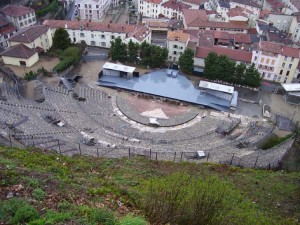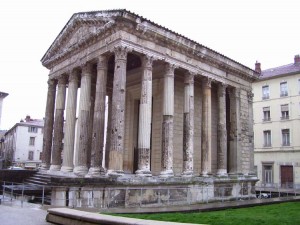THE RIVERS OF FRANCE – A BUS TRIP TO VIENNE
THE RIVERS OF FRANCE
This is the eighth in a series of articles about a boat trip on the Rhone River
A BUS TRIP TO VIENNE
By Charles N. Stevens
Photos by Dolores Seidman
We are again greeted in the morning with gray, rainy skies, the Rhone a dull, murky brown. Our ship’s crew decides not to attempt cruising north on the Saone River as planned as it is nearly at flood stage, and the current is too swift. Days of rain have melted the deep snow pack in the Alps, raising the level of Lake Geneva that feeds into the Rhone and Saone. Trees that are normally out of the water are now standing in it. The captain keeps our ship safely docked at Lyon.
Instead of traveling on the ship, we are taken by bus to the town of Vienne (not Vienna) 20 miles south of Lyon. We roll down the misty streets of outer Lyon, passing sports arenas and the city’s industrial area with its factories and burgeoning railroad yards. Sprawling chemical plants and oil refineries, steam rising from pipes and stacks, lie on the far outskirts, places we would never see from the ship.
By the time we see the Rhone again on our trip south, strong winds are churning up whitecaps. We’re glad we were not out there on our ship.
We soon reach Vienne, the town dull and gray under a cloudy sky and drizzle. Leaving our warm, comfortable bus, we board a rubber-tired train with three cars. The operator is busy wiping rainwater off the seats. Although there is a roof over each car, the sides are unprotected. We all slide into the damp seats and are off on a trip to a high hill where we can view the city. Cold wind and light rain whip in from the sides, chilling us to the bone. I zip up my jacket as far as it will go. When the train stops at the summit, conditions are a little better.
Our guide tells us that we are now on Mount Pipet. As this is the highest point in town, the people of Vienne decided to build a chapel here dedicated to the Virgin Mary. We enter its cold, dark sanctuary, admiring an intricately carved wooden pulpit standing in the shadows. Most unusual is the altar displaying Jesus on the cross along with the tools used to crucify him.
From Mount Pipet we not only look down on the town and the Rhone River, but also the intact remains of the two thousand year-old Roman Theater tucked into the side of the hill. One of the largest theaters ever built, it could seat 13,000 Romans. Today it is stone-gray and damp from the rain, but with a little imagination one can see crowds of toga-clad citizens attending a play by Plautus. In modern times the old theater rocks with the pulse of an annual jazz concert held in July.
The “train” takes us down the mountain and deposits us in town where we can explore the city by foot.
Traces of the Roman Empire are everywhere in southern France, its far flung influence evident over a large swath of Europe. In the middle of the town square, standing exactly the way it did so long ago, is the Temple of Augustus and Livia, erected in 10BC-20BC by Claudius. Dedicated to Augustus and once part of the Roman Forum, it is today surrounded by modern shops. It still appears sturdy and solid, its fluted columns, pediments and capitals remarkably preserved. Dolores and I stand across the street from it, trying to comprehend its unimaginable age. Vienne had been a Roman colony since it was established by Julius Caesar in 50BC.
Continuing our stroll into ancient history, we visit Cybele’s Archeological Garden. Within it are the remains of a neighborhood belonging to the old Gallo-Roman town. We can clearly see the partial walls and foundations of houses, dwellings once warm with life and the everyday activities of average Roman citizens. Most visible is a high-standing arch that was once part of the Roman Forum. We pass through it as thousands of ordinary Romans once did.
On the bus back to Lyon and our home on the ship, our heads are full of ancient history. We attempt to comprehend the amazing sights that we have seen. We also anticipate a delicious dinner on our ship whipped up by our talented chefs.

We look down from Mt. Pipet on the 2000 year old Roman Amphitheater.

The Temple of Augustus and Livea (20 B.C.) stands today in the center of Vienne




Very interesting article, I did enjoy very much.
“B.K.”
Marvelous…..caught the misty mood—and was fascinated by the Roman history— How ironic the Roman theatre now hosting jazz muscians….good contrast of eras.